Abstract
The purpose of this overview is to introduce the property of a new class of hazardous chemicals-the inhibitors of multixenobiotic resistance (MXR) in aquatic organisms, referred to as chemosensitizers. Aquatic organisms possess MXR, a mechanism similar to the well-known P-glycoprotein extrusion pump in multidrug resistant (MDR) tumor cells. MXR in aquatic organism moves from cells and organisms both endogenous chemicals and xenobiotics, including also some man-made chemicals. MXR in aquatic organisms represents a general biological first-line defense mechanism for protection against environmental toxins. Many chemical agents, the chemosensitizers, may after the function of this fragile mechanism. It is this new, MXR-inhibiting property, unrecognized as yet, that classifies these chemicals among top-rank hazardous water pollutants. The knowledge that the presence of one xenobiotic may block the pumping out of other xenobiotic(s), and hence accelerate their accumulation, may have important implications on environmental parameters like exposure, uptake, bioaccumulation, and toxicity. In this overview we present the evidence for the expression of MXR-phenotype in aquatic organisms, the demonstration of toxic consequences caused by MXR inhibitors, and the description of methods for measurement of concentration of MXR inhibitors in environmental samples.
Full text
PDF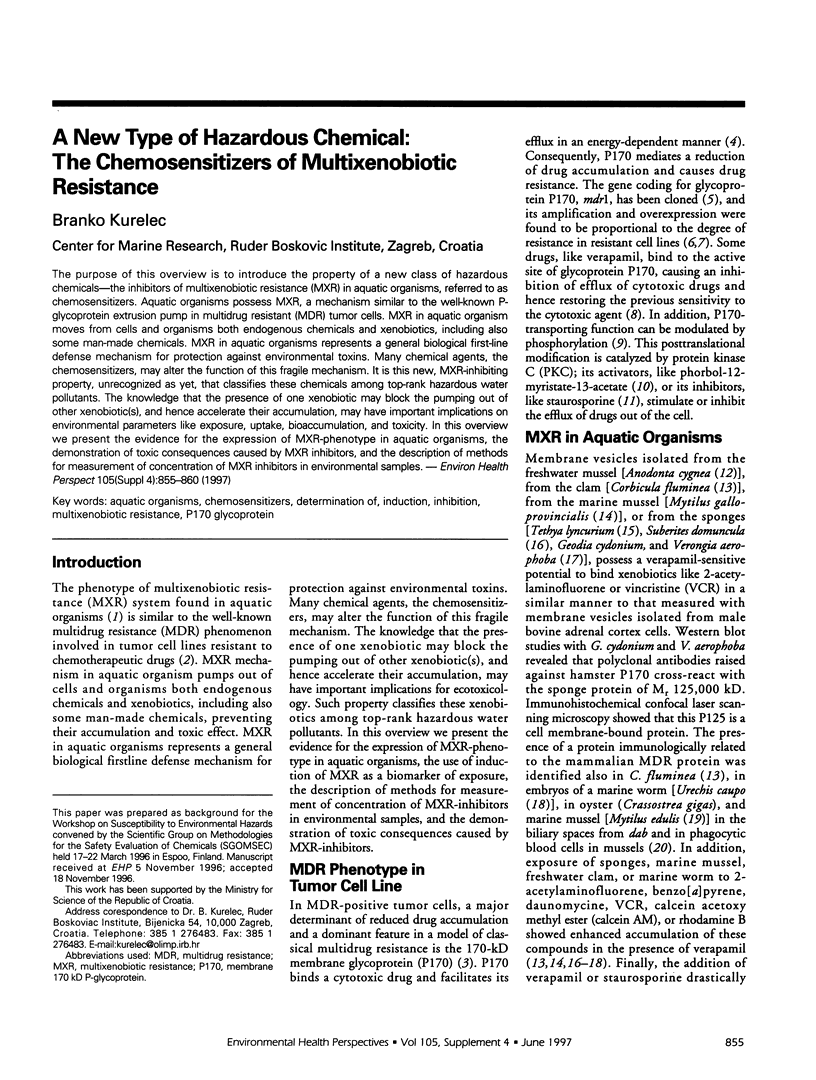
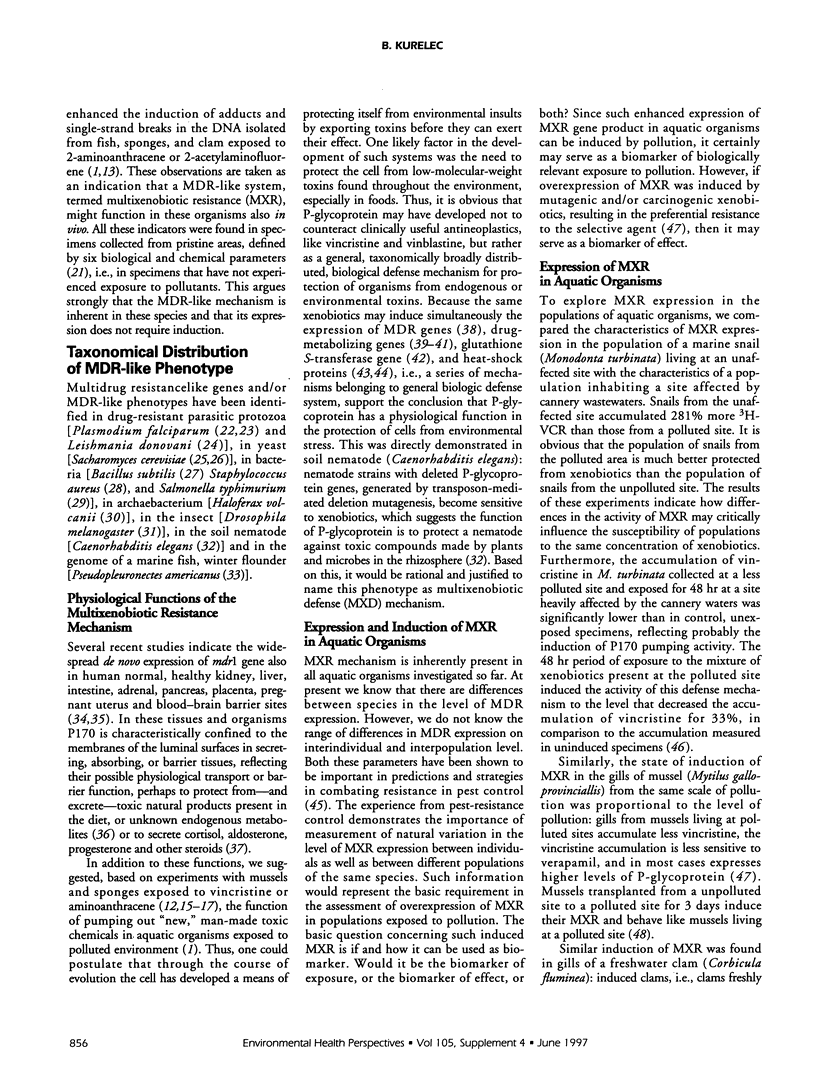
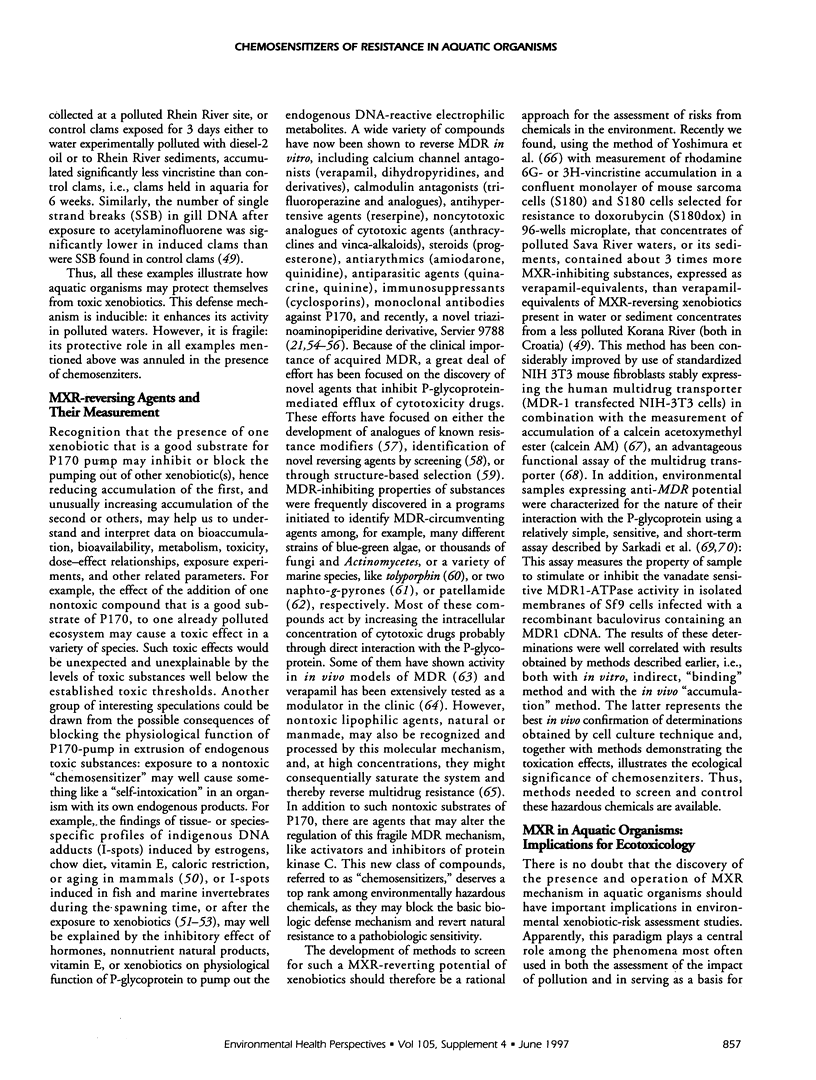
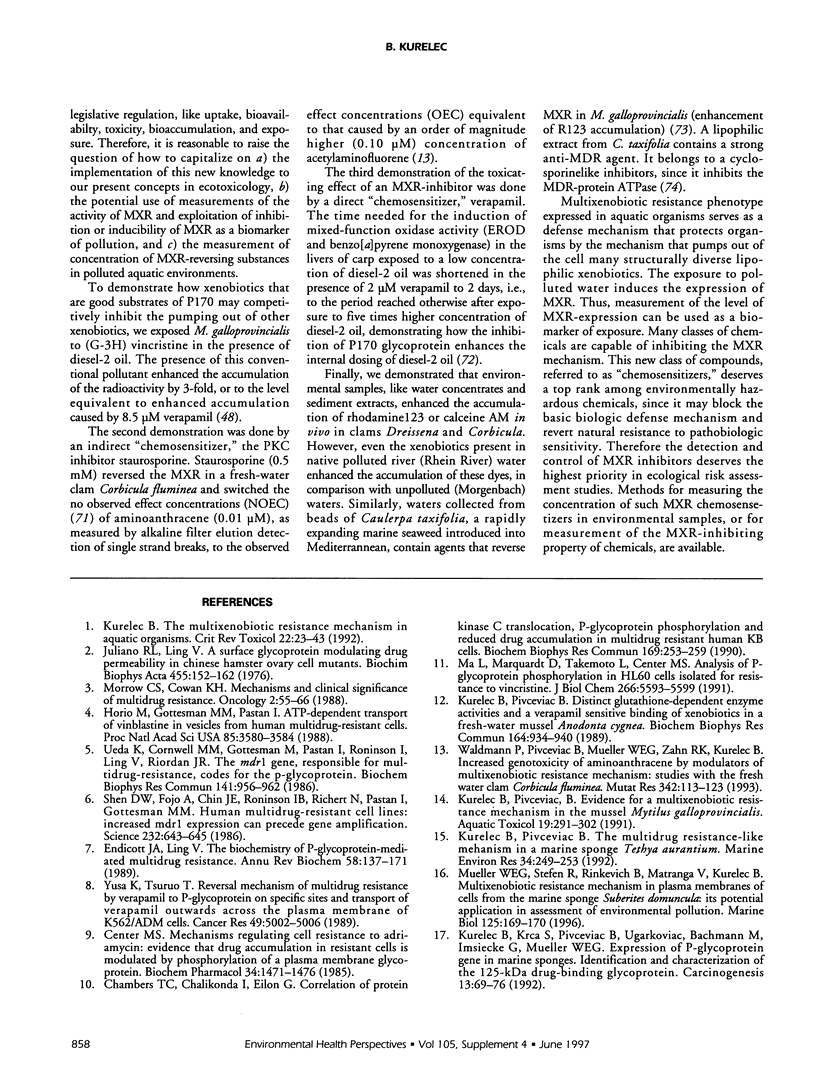
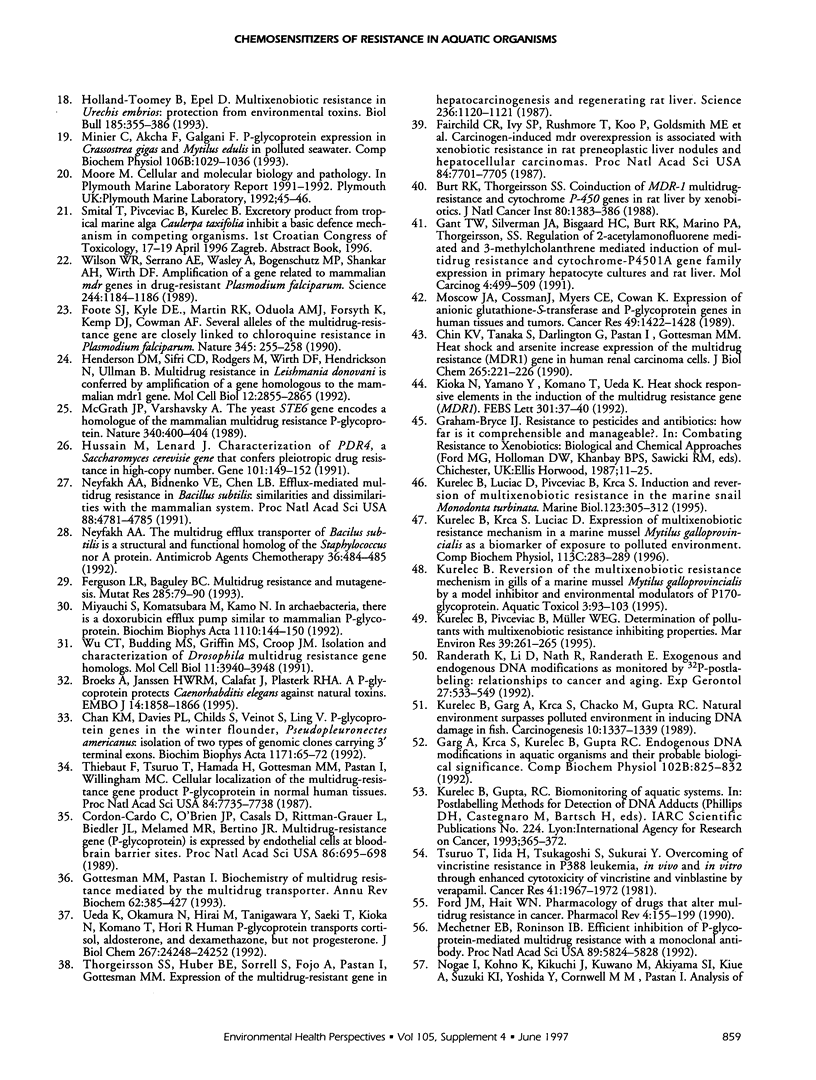
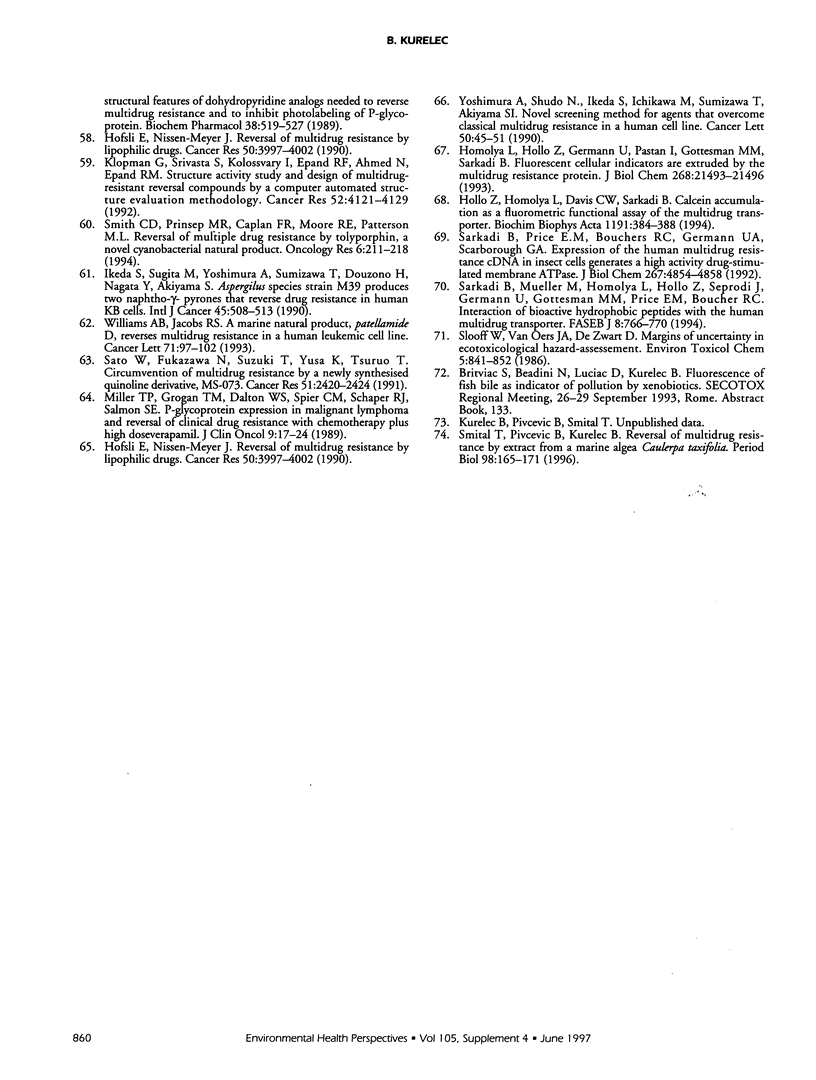
Selected References
These references are in PubMed. This may not be the complete list of references from this article.
- Broeks A., Janssen H. W., Calafat J., Plasterk R. H. A P-glycoprotein protects Caenorhabditis elegans against natural toxins. EMBO J. 1995 May 1;14(9):1858–1866. doi: 10.1002/j.1460-2075.1995.tb07178.x. [DOI] [PMC free article] [PubMed] [Google Scholar]
- Burt R. K., Thorgeirsson S. S. Coinduction of MDR-1 multidrug-resistance and cytochrome P-450 genes in rat liver by xenobiotics. J Natl Cancer Inst. 1988 Nov 2;80(17):1383–1386. doi: 10.1093/jnci/80.17.1383. [DOI] [PubMed] [Google Scholar]
- Center M. S. Mechanisms regulating cell resistance to adriamycin. Evidence that drug accumulation in resistant cells is modulated by phosphorylation of a plasma membrane glycoprotein. Biochem Pharmacol. 1985 May 1;34(9):1471–1476. doi: 10.1016/0006-2952(85)90686-0. [DOI] [PubMed] [Google Scholar]
- Chambers T. C., Chalikonda I., Eilon G. Correlation of protein kinase C translocation, P-glycoprotein phosphorylation and reduced drug accumulation in multidrug resistant human KB cells. Biochem Biophys Res Commun. 1990 May 31;169(1):253–259. doi: 10.1016/0006-291x(90)91461-z. [DOI] [PubMed] [Google Scholar]
- Chan K. M., Davies P. L., Childs S., Veinot L., Ling V. P-glycoprotein genes in the winter flounder, Pleuronectes americanus: isolation of two types of genomic clones carrying 3' terminal exons. Biochim Biophys Acta. 1992 Nov 15;1171(1):65–72. doi: 10.1016/0167-4781(92)90140-u. [DOI] [PubMed] [Google Scholar]
- Chin K. V., Tanaka S., Darlington G., Pastan I., Gottesman M. M. Heat shock and arsenite increase expression of the multidrug resistance (MDR1) gene in human renal carcinoma cells. J Biol Chem. 1990 Jan 5;265(1):221–226. [PubMed] [Google Scholar]
- Cordon-Cardo C., O'Brien J. P., Casals D., Rittman-Grauer L., Biedler J. L., Melamed M. R., Bertino J. R. Multidrug-resistance gene (P-glycoprotein) is expressed by endothelial cells at blood-brain barrier sites. Proc Natl Acad Sci U S A. 1989 Jan;86(2):695–698. doi: 10.1073/pnas.86.2.695. [DOI] [PMC free article] [PubMed] [Google Scholar]
- Endicott J. A., Ling V. The biochemistry of P-glycoprotein-mediated multidrug resistance. Annu Rev Biochem. 1989;58:137–171. doi: 10.1146/annurev.bi.58.070189.001033. [DOI] [PubMed] [Google Scholar]
- Fairchild C. R., Ivy S. P., Rushmore T., Lee G., Koo P., Goldsmith M. E., Myers C. E., Farber E., Cowan K. H. Carcinogen-induced mdr overexpression is associated with xenobiotic resistance in rat preneoplastic liver nodules and hepatocellular carcinomas. Proc Natl Acad Sci U S A. 1987 Nov;84(21):7701–7705. doi: 10.1073/pnas.84.21.7701. [DOI] [PMC free article] [PubMed] [Google Scholar]
- Ferguson L. R., Baguley B. C. Multidrug resistance and mutagenesis. Mutat Res. 1993 Jan;285(1):79–90. doi: 10.1016/0027-5107(93)90054-j. [DOI] [PubMed] [Google Scholar]
- Foote S. J., Kyle D. E., Martin R. K., Oduola A. M., Forsyth K., Kemp D. J., Cowman A. F. Several alleles of the multidrug-resistance gene are closely linked to chloroquine resistance in Plasmodium falciparum. Nature. 1990 May 17;345(6272):255–258. doi: 10.1038/345255a0. [DOI] [PubMed] [Google Scholar]
- Ford J. M., Hait W. N. Pharmacology of drugs that alter multidrug resistance in cancer. Pharmacol Rev. 1990 Sep;42(3):155–199. [PubMed] [Google Scholar]
- Gant T. W., Silverman J. A., Bisgaard H. C., Burt R. K., Marino P. A., Thorgeirsson S. S. Regulation of 2-acetylaminofluorene-and 3-methylcholanthrene--mediated induction of multidrug resistance and cytochrome P450IA gene family expression in primary hepatocyte cultures and rat liver. Mol Carcinog. 1991;4(6):499–509. doi: 10.1002/mc.2940040614. [DOI] [PubMed] [Google Scholar]
- Gottesman M. M., Pastan I. Biochemistry of multidrug resistance mediated by the multidrug transporter. Annu Rev Biochem. 1993;62:385–427. doi: 10.1146/annurev.bi.62.070193.002125. [DOI] [PubMed] [Google Scholar]
- Henderson D. M., Sifri C. D., Rodgers M., Wirth D. F., Hendrickson N., Ullman B. Multidrug resistance in Leishmania donovani is conferred by amplification of a gene homologous to the mammalian mdr1 gene. Mol Cell Biol. 1992 Jun;12(6):2855–2865. doi: 10.1128/mcb.12.6.2855. [DOI] [PMC free article] [PubMed] [Google Scholar]
- Hofsli E., Nissen-Meyer J. Reversal of multidrug resistance by lipophilic drugs. Cancer Res. 1990 Jul 1;50(13):3997–4002. [PubMed] [Google Scholar]
- Hofsli E., Nissen-Meyer J. Reversal of multidrug resistance by lipophilic drugs. Cancer Res. 1990 Jul 1;50(13):3997–4002. [PubMed] [Google Scholar]
- Holló Z., Homolya L., Davis C. W., Sarkadi B. Calcein accumulation as a fluorometric functional assay of the multidrug transporter. Biochim Biophys Acta. 1994 May 11;1191(2):384–388. doi: 10.1016/0005-2736(94)90190-2. [DOI] [PubMed] [Google Scholar]
- Homolya L., Holló Z., Germann U. A., Pastan I., Gottesman M. M., Sarkadi B. Fluorescent cellular indicators are extruded by the multidrug resistance protein. J Biol Chem. 1993 Oct 15;268(29):21493–21496. [PubMed] [Google Scholar]
- Horio M., Gottesman M. M., Pastan I. ATP-dependent transport of vinblastine in vesicles from human multidrug-resistant cells. Proc Natl Acad Sci U S A. 1988 May;85(10):3580–3584. doi: 10.1073/pnas.85.10.3580. [DOI] [PMC free article] [PubMed] [Google Scholar]
- Hussain M., Lenard J. Characterization of PDR4, a Saccharomyces cerevisiae gene that confers pleiotropic drug resistance in high-copy number: identity with YAP1, encoding a transcriptional activator [corrected]. Gene. 1991 May 15;101(1):149–152. doi: 10.1016/0378-1119(91)90238-7. [DOI] [PubMed] [Google Scholar]
- Ikeda S., Sugita M., Yoshimura A., Sumizawa T., Douzono H., Nagata Y., Akiyama S. Aspergillus species strain M39 produces two naphtho-gamma-pyrones that reverse drug resistance in human KB cells. Int J Cancer. 1990 Mar 15;45(3):508–513. doi: 10.1002/ijc.2910450323. [DOI] [PubMed] [Google Scholar]
- Juliano R. L., Ling V. A surface glycoprotein modulating drug permeability in Chinese hamster ovary cell mutants. Biochim Biophys Acta. 1976 Nov 11;455(1):152–162. doi: 10.1016/0005-2736(76)90160-7. [DOI] [PubMed] [Google Scholar]
- Kioka N., Yamano Y., Komano T., Ueda K. Heat-shock responsive elements in the induction of the multidrug resistance gene (MDR1). FEBS Lett. 1992 Apr 13;301(1):37–40. doi: 10.1016/0014-5793(92)80205-u. [DOI] [PubMed] [Google Scholar]
- Klopman G., Srivastava S., Kolossvary I., Epand R. F., Ahmed N., Epand R. M. Structure-activity study and design of multidrug-resistant reversal compounds by a computer automated structure evaluation methodology. Cancer Res. 1992 Aug 1;52(15):4121–4129. [PubMed] [Google Scholar]
- Kurelec B., Garg A., Krca S., Chacko M., Gupta R. C. Natural environment surpasses polluted environment in inducing DNA damage in fish. Carcinogenesis. 1989 Jul;10(7):1337–1339. doi: 10.1093/carcin/10.7.1337. [DOI] [PubMed] [Google Scholar]
- Kurelec B., Krca S., Pivcevic B., Ugarković D., Bachmann M., Imsiecke G., Müller W. E. Expression of P-glycoprotein gene in marine sponges. Identification and characterization of the 125 kDa drug-binding glycoprotein. Carcinogenesis. 1992 Jan;13(1):69–76. doi: 10.1093/carcin/13.1.69. [DOI] [PubMed] [Google Scholar]
- Kurelec B., Pivcević B. Distinct glutathione-dependent enzyme activities and a verapamil-sensitive binding of xenobiotics in a fresh-water mussel Anodonta cygnea. Biochem Biophys Res Commun. 1989 Oct 31;164(2):934–940. doi: 10.1016/0006-291x(89)91548-9. [DOI] [PubMed] [Google Scholar]
- Kurelec B. The multixenobiotic resistance mechanism in aquatic organisms. Crit Rev Toxicol. 1992;22(1):23–43. doi: 10.3109/10408449209145320. [DOI] [PubMed] [Google Scholar]
- Ma L. D., Marquardt D., Takemoto L., Center M. S. Analysis of P-glycoprotein phosphorylation in HL60 cells isolated for resistance to vincristine. J Biol Chem. 1991 Mar 25;266(9):5593–5599. [PubMed] [Google Scholar]
- McGrath J. P., Varshavsky A. The yeast STE6 gene encodes a homologue of the mammalian multidrug resistance P-glycoprotein. Nature. 1989 Aug 3;340(6232):400–404. doi: 10.1038/340400a0. [DOI] [PubMed] [Google Scholar]
- Mechetner E. B., Roninson I. B. Efficient inhibition of P-glycoprotein-mediated multidrug resistance with a monoclonal antibody. Proc Natl Acad Sci U S A. 1992 Jul 1;89(13):5824–5828. doi: 10.1073/pnas.89.13.5824. [DOI] [PMC free article] [PubMed] [Google Scholar]
- Miller T. P., Grogan T. M., Dalton W. S., Spier C. M., Scheper R. J., Salmon S. E. P-glycoprotein expression in malignant lymphoma and reversal of clinical drug resistance with chemotherapy plus high-dose verapamil. J Clin Oncol. 1991 Jan;9(1):17–24. doi: 10.1200/JCO.1991.9.1.17. [DOI] [PubMed] [Google Scholar]
- Minier C., Akcha F., Galgani F. P-glycoprotein expression in Crassostrea gigas and Mytilus edulis in polluted seawater. Comp Biochem Physiol B. 1993 Dec;106(4):1029–1036. doi: 10.1016/0305-0491(93)90068-g. [DOI] [PubMed] [Google Scholar]
- Miyauchi S., Komatsubara M., Kamo N. In archaebacteria, there is a doxorubicin efflux pump similar to mammalian P-glycoprotein. Biochim Biophys Acta. 1992 Oct 5;1110(2):144–150. doi: 10.1016/0005-2736(92)90351-l. [DOI] [PubMed] [Google Scholar]
- Morrow C. S., Cowan K. H. Mechanisms and clinical significance of multidrug resistance. Oncology (Williston Park) 1988 Oct;2(10):55-63, 66-8. [PubMed] [Google Scholar]
- Moscow J. A., Fairchild C. R., Madden M. J., Ransom D. T., Wieand H. S., O'Brien E. E., Poplack D. G., Cossman J., Myers C. E., Cowan K. H. Expression of anionic glutathione-S-transferase and P-glycoprotein genes in human tissues and tumors. Cancer Res. 1989 Mar 15;49(6):1422–1428. [PubMed] [Google Scholar]
- Neyfakh A. A., Bidnenko V. E., Chen L. B. Efflux-mediated multidrug resistance in Bacillus subtilis: similarities and dissimilarities with the mammalian system. Proc Natl Acad Sci U S A. 1991 Jun 1;88(11):4781–4785. doi: 10.1073/pnas.88.11.4781. [DOI] [PMC free article] [PubMed] [Google Scholar]
- Neyfakh A. A. The multidrug efflux transporter of Bacillus subtilis is a structural and functional homolog of the Staphylococcus NorA protein. Antimicrob Agents Chemother. 1992 Feb;36(2):484–485. doi: 10.1128/aac.36.2.484. [DOI] [PMC free article] [PubMed] [Google Scholar]
- Randerath K., Li D., Nath R., Randerath E. Exogenous and endogenous DNA modifications as monitored by 32P-postlabeling: relationships to cancer and aging. Exp Gerontol. 1992 Sep-Dec;27(5-6):533–549. doi: 10.1016/0531-5565(92)90008-n. [DOI] [PubMed] [Google Scholar]
- Sarkadi B., Müller M., Homolya L., Holló Z., Seprödi J., Germann U. A., Gottesman M. M., Price E. M., Boucher R. C. Interaction of bioactive hydrophobic peptides with the human multidrug transporter. FASEB J. 1994 Jul;8(10):766–770. doi: 10.1096/fasebj.8.10.7914178. [DOI] [PubMed] [Google Scholar]
- Sarkadi B., Price E. M., Boucher R. C., Germann U. A., Scarborough G. A. Expression of the human multidrug resistance cDNA in insect cells generates a high activity drug-stimulated membrane ATPase. J Biol Chem. 1992 Mar 5;267(7):4854–4858. [PubMed] [Google Scholar]
- Sato W., Fukazawa N., Suzuki T., Yusa K., Tsuruo T. Circumvention of multidrug resistance by a newly synthesized quinoline derivative, MS-073. Cancer Res. 1991 May 1;51(9):2420–2424. [PubMed] [Google Scholar]
- Shen D. W., Fojo A., Chin J. E., Roninson I. B., Richert N., Pastan I., Gottesman M. M. Human multidrug-resistant cell lines: increased mdr1 expression can precede gene amplification. Science. 1986 May 2;232(4750):643–645. doi: 10.1126/science.3457471. [DOI] [PubMed] [Google Scholar]
- Smith C. D., Prinsep M. R., Caplan F. R., Moore R. E., Patterson G. M. Reversal of multiple drug resistance by tolyporphin, a novel cyanobacterial natural product. Oncol Res. 1994;6(4-5):211–218. [PubMed] [Google Scholar]
- Thiebaut F., Tsuruo T., Hamada H., Gottesman M. M., Pastan I., Willingham M. C. Cellular localization of the multidrug-resistance gene product P-glycoprotein in normal human tissues. Proc Natl Acad Sci U S A. 1987 Nov;84(21):7735–7738. doi: 10.1073/pnas.84.21.7735. [DOI] [PMC free article] [PubMed] [Google Scholar]
- Thorgeirsson S. S., Huber B. E., Sorrell S., Fojo A., Pastan I., Gottesman M. M. Expression of the multidrug-resistant gene in hepatocarcinogenesis and regenerating rat liver. Science. 1987 May 29;236(4805):1120–1122. doi: 10.1126/science.3576227. [DOI] [PubMed] [Google Scholar]
- Tsuruo T., Iida H., Tsukagoshi S., Sakurai Y. Overcoming of vincristine resistance in P388 leukemia in vivo and in vitro through enhanced cytotoxicity of vincristine and vinblastine by verapamil. Cancer Res. 1981 May;41(5):1967–1972. [PubMed] [Google Scholar]
- Ueda K., Cornwell M. M., Gottesman M. M., Pastan I., Roninson I. B., Ling V., Riordan J. R. The mdr1 gene, responsible for multidrug-resistance, codes for P-glycoprotein. Biochem Biophys Res Commun. 1986 Dec 30;141(3):956–962. doi: 10.1016/s0006-291x(86)80136-x. [DOI] [PubMed] [Google Scholar]
- Ueda K., Okamura N., Hirai M., Tanigawara Y., Saeki T., Kioka N., Komano T., Hori R. Human P-glycoprotein transports cortisol, aldosterone, and dexamethasone, but not progesterone. J Biol Chem. 1992 Dec 5;267(34):24248–24252. [PubMed] [Google Scholar]
- Waldmann P., Pivcevic B., Müller W. E., Zahn R. K., Kurelec B. Increased genotoxicity of acetylaminofluorene by modulators of multixenobiotic resistance mechanism: studies with the fresh water clam Corbicula fluminea. Mutat Res. 1995 Apr;342(3-4):113–123. doi: 10.1016/0165-1218(95)90021-7. [DOI] [PubMed] [Google Scholar]
- Williams A. B., Jacobs R. S. A marine natural product, patellamide D, reverses multidrug resistance in a human leukemic cell line. Cancer Lett. 1993 Jul 30;71(1-3):97–102. doi: 10.1016/0304-3835(93)90103-g. [DOI] [PubMed] [Google Scholar]
- Wilson C. M., Serrano A. E., Wasley A., Bogenschutz M. P., Shankar A. H., Wirth D. F. Amplification of a gene related to mammalian mdr genes in drug-resistant Plasmodium falciparum. Science. 1989 Jun 9;244(4909):1184–1186. doi: 10.1126/science.2658061. [DOI] [PubMed] [Google Scholar]
- Wu C. T., Budding M., Griffin M. S., Croop J. M. Isolation and characterization of Drosophila multidrug resistance gene homologs. Mol Cell Biol. 1991 Aug;11(8):3940–3948. doi: 10.1128/mcb.11.8.3940. [DOI] [PMC free article] [PubMed] [Google Scholar]
- Yoshimura A., Shudo N., Ikeda S. I., Ichikawa M., Sumizawa T., Akiyama S. I. Novel screening method for agents that overcome classical multidrug resistance in a human cell line. Cancer Lett. 1990 Apr 9;50(1):45–51. doi: 10.1016/0304-3835(90)90177-y. [DOI] [PubMed] [Google Scholar]
- Yusa K., Tsuruo T. Reversal mechanism of multidrug resistance by verapamil: direct binding of verapamil to P-glycoprotein on specific sites and transport of verapamil outward across the plasma membrane of K562/ADM cells. Cancer Res. 1989 Sep 15;49(18):5002–5006. [PubMed] [Google Scholar]


